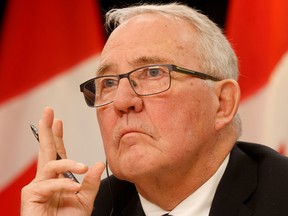The policy places an emphasis on defending Canada’s northern border amid growing threats from Russia and China

Article content
OTTAWA — The federal government presented an ambitious reform of its defence policy Monday with a renewed focus on securing Canada’s arctic border and recruitment but that still stops short of hitting the two percent defence spending target expected of NATO partners.
The updated policy — called Our North, Strong and Free — promises $8.1 billion in further investments in Canada’s defence capabilities over the next five years in addition to major equipment purchases such as a new fleet of F-35 fighter jets and upgrading NORAD equipment.
Advertisement 2
Article content
Article content
Despite the new planned spending, Canada’s defence spending will still only reach 1.76 per cent of its GDP by 2029-2030 according to the document, meaning the country still has no timeline for when it will hit the two per cent target NATO members re-committed to in 2023.
During a background technical briefing to the media on Monday morning, Department of National Defence officials said that even if the federal government immediately invested that money as of this year, the military wouldn’t yet be able to spend it all.
“I think we would need to build towards that. It takes a while to invest in and build military capabilities,” said the official.
The new policy, which updates the 2017 Strong, Secure, Engaged document, also places a new emphasis on defending Canada’s northern border amid growing military and economic threats from Russia and China.
“We are seeing greater Russian activity in our air approaches, and a growing number of Chinese vessels and surveillance platforms are mapping and collecting data about the region,” Defence Minister Bill Blair wrote in the new policy.
Article content
Advertisement 3
Article content
“As the Arctic becomes more accessible to foreign actors, we need to ensure our military has the tools to assert our sovereignty and protect Canada’s interests.”
During a press conference, Prime Minister Justin Trudeau said melting ice in the North due to climate change could create a new major shipping route that Canada needs to prepare for.
“The Northwest Passage could become the most efficient shipping route between Europe and Asia by 2050. That’s just 26 years away,” he said.
Personnel recruitment and retention is also a key part of the updated policy.
During the briefing, a DND official said Canada’s military is roughly 15,000 members short, a concerning gap that needs to be addressed urgently.
“The current gap between the Canadian Armed Forces’ actual force size and our authorized force size is unsustainable and needs to be filled rapidly,” reads the new policy.
To do so, the government promises to implement measures designed to “hire by default” namely by shortening recruitment times, setting up a “probationary” period to speed up enrolment and reducing the time required for security clearances.
Advertisement 4
Article content
The department will also re-evaluate the “outdated” medical requirements for new recruits though it promises it will not lower the bar for entry into the military.
Retention has also become an issue for the CAF that leadership aims to address. In exit interviews, an official at the technical briefing said outgoing members frequently highlight quality of life issues, the constant movement across Canada and cost of living issues.
“We are, through this policy, implementing new ways to lessen the burden on the military life for CAF members and their families,” the official said.
More to come.
Get even more deep-dive National Post political coverage and analysis in your inbox with the Political Hack newsletter, where Ottawa bureau chief Stuart Thomson and political analyst Tasha Kheiriddin get at what’s really going on behind the scenes on Parliament Hill every Wednesday and Friday, exclusively for subscribers. Sign up here.
Our website is the place for the latest breaking news, exclusive scoops, longreads and provocative commentary. Please bookmark nationalpost.com and sign up for our daily newsletter, Posted, here.
Article content



